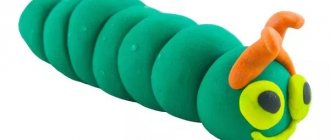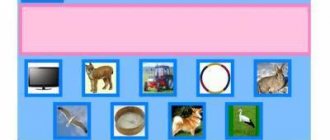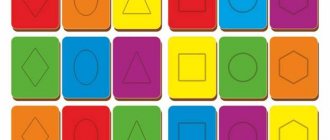Didactic games in fine art senior group
Didactic games for art activities in seniors.
D/I “Guess what happens?”
Target:
Develop imagination, fantasy, creativity.
Material:
Sheet of paper, pencils.
Exercise:
The teacher invites one of the children to start imitating
object (line), but not completely. The next one says that this may be and draws another line. The next one must come up with something else and finish it in accordance with his plan. This continues until one of the players can no longer change the drawing in his own way. The one who made the last change wins.
D/I “Magic Palette”
Target:
Develop a sense of color.
Material:
Gouache. Palette.
Exercise:
The teacher invites the children to play with the palette and paints. By mixing paints you can get different shades of colors. You can suggest depicting how the sky brightens at dawn using blue and white paints. You need to whiten the blue paint on a palette, gradually adding white and successively applying strokes to a sheet of paper. The main thing is to ensure that the shades change as evenly as possible. Invite the children to draw how the sun sets (from orange to red), how the leaves turn yellow in the fall (from green to yellow).
D/I “What doesn’t happen in the world?”
Target:
Develop creative imagination.
Material:
Colour pencils. Paper.
Exercise:
The teacher asks the child to draw something that does not exist in the world. Then he asks to tell what he drew and discuss the drawing: whether what is depicted on it really does not occur in life.
D/I “What could this be?”
Target:
Develop imagination.
Material:
Gouache. Palettes.
Exercise:
The teacher invites children to draw sweet, round, fragrant, fresh, fragrant, salty, green, etc. The game can be repeated several times, using new material each time.
D/I “Tell me about their mood”
Target:
Develop perception, attention, imagination.
Material:
Illustrations depicting people's faces expressing various emotional states. Paper. Colour pencils.
Exercise:
The teacher suggests looking at a picture depicting a person’s face and talking about his mood. Invite children to draw a face - a riddle. The game can be repeated with different materials.
D/I “Let’s help the artist”
Target:
Develop creative imagination.
Material:
Colour pencils. Paper.
Target:
The teacher invites the children to draw an unusual car that will take them to a magical land. Draw and tell about your car.
D/I “Invent it yourself”
Target:
Develop imagination and fantasy.
Material:
Paper. Paints. Palettes. Markers.
Exercise:
The teacher invites the child to imagine that he has flown to another planet and draw what he could see there. When the drawing is ready, you can invite the child to come up with a story.
D/I “Magic Pictures”
Target:
Teach children to create images based on a schematic representation of an object.
Material:
A piece of paper with an unfinished image. Colour pencils.
Exercise:
Complete the picture. Mark the most interesting pictures when the guys come up with something of their own, unlike other pictures.
D/I “Merry Palette”
Target:
Develop a sense of color.
Material:
Cards with objects. Palettes with shades of colors.
Exercise:
Name each picture and show its color on the palette. Pick up all the pairs: lemon - lemon... (etc.) Now try to guess what other colors can be called. Find the carrot among the pictures and the matching one on the palette. What is this color called? (Orange.) But you can say it in another way - carrot. Show beet color on your palette. Lilac. Olive. If it’s difficult, compare with images of fruits and flowers. What would you call the color of plum? (Purple, or otherwise plum.) How is yellow different from lemon? (Lemon is a shade of yellow with a hint of green.)
D/I "Klubochki"
Target:
To develop in children the ability to perform circular movements when drawing a ball in a closed circle, relying on visual control and with their eyes closed.
Material:
Picture "Kitten with a ball." Sheets of paper. Pencils.
Exercise:
The teacher invites the children to look at a picture of a kitten playing with a ball of thread. Then he invites the children to collect the threads into a ball and shows how the threads are collected into a ball, imitating with the movements of a pencil winding the threads into a ball. Periodically, the teacher invites children to close their eyes and perform movements with their eyes closed.
In order for children to show interest in work, you can give them the opportunity to draw a lot of balls, arrange a competition: who can draw the most balls.
D/I “Symmetrical objects”
Target:
Reinforce with children the idea of symmetrical objects and familiarization with the profession of a potter.
Materials:
Templates of jugs, vases and pots, cut along the axis of symmetry.
Exercise:
The potter broke all the pots and vases that he had made for sale at the fair. All the fragments were mixed up. We need to help the potter collect and “glue” all his products.
D/I "Cheerful Dwarf"
Target:
Teach children to create images based on the perception of a schematic image of an object.
Material:
A picture depicting a gnome with a bag in his hands and several bags of different shapes cut out of paper, which can be superimposed on the picture and changed in the gnome’s hands.
Exercise:
The teacher shows the children a picture and says that a gnome came to visit the children; he brought gifts, but what the children must guess and draw.
D/I “Wonderful Forest”
Purpose:
To teach children to create situations in their imagination based on their schematic representation.
Material:
Sheets of paper on which several trees are drawn and unfinished, unformed images are located in different places.
Colour pencils.
Exercise:
The teacher hands out sheets of paper to the children and asks them to draw a forest.
full of miracles, and then come up with and tell a story about it.
D/I “Shifters”
Purpose:
To teach children to create in their imagination images of objects based on the perception of schematic images of individual parts of these objects.
Material:
Pencils. Sheets of paper with the image of half of an object.
Exercise:
The teacher invites the children to draw whatever they want to the figure, but so that it turns out to be a picture. Then you need to take another card with the same figure, put it upside down or sideways and turn the figure into another picture. When the children complete the task, take cards with another figure.
D/I “Make a portrait”
Target:
To consolidate knowledge about the genre of portraiture.
Develop a sense of proportion. Material:
Various modifications of face parts. Paper. Colour pencils.
Exercise:
The teacher invites children to make a portrait from different parts of the face.
Determine the mood and draw a portrait.
D/I "Underwater World"
Purpose of the game:
Strengthen children's knowledge about the inhabitants of the underwater world. Teach children to carefully examine the shape, color, and structural features of underwater inhabitants. Learn to create a multifaceted composition using underpainting. Develop fine motor skills. Activate children's vocabulary.
Material:
Illustrations depicting the inhabitants of the underwater world. Paper. Watercolor.
Exercise:
Together with the teacher, children remember who lives in the seas and oceans, clarify their body structure and coloring. Then, in the underpaintings, children create a picture of the underwater world, arranging objects in a multifaceted manner. The chip goes to the child who created a more interesting picture, the one who used a lot of details to create a picture of the underwater world.





